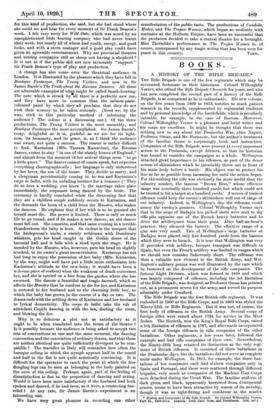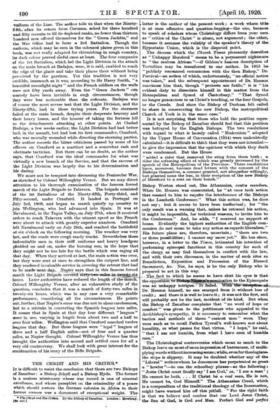BOOKS.
A HISTORY OF THE RIFLE BRIGADE.*
THE Rifle Brigade is one of the few regiments which may be accounted fortunate in their historians. Colonel Willoughby Verner, who edited the Rifle Brigade Chronicle for years, and who has now completed the second part of a history of the Rifle Brigade, is as competent as he is enthusiastic. His new volume, on the five years from 1809 to 1813, testifies to much patient research in the records, supplemented by regimental tradition and by personal knowledge of the battlefields, which is peculiarly valuable, for example, in the case of Barrosa. Moreover, Colonel Willoughby Verner is a pleasant and lucid writer and his maps are excellent. It might be thought that there was nothing new to say about the Peninsular War, after Napier, Professor Oman, and Mr. Fortescue, but the author's treatment of the familiar theme is surprisingly fresh and instructive. Companies of the Rifle Brigade were present at every important action in the Peninsula, except Albuera, so that its historian was bound to consider the campaigns as a whole. Wellington attached great importance to his riflemen, as part of the dense screen of skirmishers which he invariably threw out in front of his main body before a battle. His object was to protect his line as far as possible from harassing fire until the action began. For skirmishing the rifle was obviously far more useful than the infantry musket, the famous " Brown Bess," whose effective range was nominally three hundred yards, but which could not be trusted to hit a target at a hundred yards. A screen of trained riflemen could keep the enemy's skirmishers well out of range of our infantry. Indeed, in Wellington's day the rifleman could annoy the enemy's gunners. Colonel Willoughby Verner says that in the siege of Badajoz ten picked shots were sent to dig rifle-pits opposite one of the French heavy batteries and to drive the artillerymen from their guns. After half-an-hour's practice, they silenced the battery. The effective range of a gun was very small. Two of Wellington's siege batteries at Badajoz were placed only five hundred yards from the bastion which they were to breach. It is true that Wellington was very ill provided with artillery, because transport was difficult in Spain, but even the French artillery was limited to ranges which we should now consider ludicrously short. The rifleman was thus a valuable new element in the British Army, and Wel- lington's military genius was well illustrated by the care which he bestowed on the development of the rifle companies. The famous Light Division. which was formed in 1810 and which was largely composed of riflemen, including the 1st Battalion of the Rifle Brigade, was designed, as Professor Oman has pointed out, as a permanent screen for the army, and served its purpose admirably under Craufurd.
The Rifle Brigade was the first British rifle regiment. It was embodied in 1800 as the Rifle Corps, and in 1803 was styled the Ninety-fifth or Rifle Regiment. But it was not, of course, the first body of riflemen in the British Army. Several corps of foreign rifles were raised about 1794 for service in the West Indies. The Sixtieth, now the King's Royal Rifle Corps, raised a 5th Battalion of riflemen in 1797, and afterwards incorporated some of the foreign riflemen in rifle companies of the other battalions. Other regiments, a few years later, followed the example and had rifle companies of their own. Nevertheless, the Ninety-fifth long retained its distinction as the only regi- ment of British riflemen. It consisted of three battalions in the Peninsular days, but the battalions did not serve as complete units under Wellington. In 1811, for example, the three bat- talions of ten companies each had sixteen companies only in Spain and Portugal, and these were scattered through different brigades, very much as companies of the Machine Gun Corps were detached during the Great War. The familiar uniform of dark green and black, apparently borrowed from Continental armies, seems to have been attractive by reason of its novelty, though it was as tight-fitting and cumbrous as the scarlet
• History and Campaigns of The Rifie Brigade. By Colonel Willoughby Verner. Part IL. 1809-1813. London: John Dale. Sono, and Danielsson. [42a. net.]
uniform of the Line. The author tells us that when the Ninety- fifth, after its return from Corunna, asked for three hundred and fifty recruits to fill its depleted ranks, no fewer than thirteen hundred men offered themselves for the " Green Jackhts," and the War Office had to form a 3rd Battalion. Though the uniform, which may be seen in the coloured plates given in this book, was not really adapted for skirmishing in rough country, Its dark colour proved useful once at least. The four companies of the 1st Battalion, which led the Light Division in the attack on the main breach at Badajoz, were, it is said, enabled to reach the edge of the glacis and take their places there without being perceived by the garrison. Yet this tradition is not very credible, inasmuch as it was, according to Sir Harry Smith, " a beautiful moonlight night " and the French soldiers on the walls were not fifty yards away. Even the " Green Jackets " cah scarcely have been invisible in such circumstances, though they were less noticeable than the redcoats. Bads* was of course the most severe test that the Light Division, and the Ninety-fifth, had in these trying years. For the stormers failed at the main breach, despite their desperate bravery and their heavy losses, and the honour of taking the fortress fell to the detachments attacking at other points. At Carded Rodrigo, a few weeks earlier, the Light Division had had better luck in the assault, but had lost its first commander, Craufurd, who was mortally wounded while directing the storming parties. The author records the bitter criticisms passed by some of his officers on Craufurd as a martinet and a somewhat rash and obstinate tactician. But there can be no doubt, as the author says, that Craufurd was the ideal commander for what was virtually a new branch of the Service, and that the success of the Light Division was largely due to his determination and his daring.
We must not be tempted into discussing the Peninsular War, as sketched by Colonel Willoughby Verner. But we may direct attention to his thorough examination of the famous forced march of the Light Brigade to Talavera. The brigade consisted of the 1st Battalions of the Ninety-fifth, Forty-third, and Fifty-second, under Craufurd. It landed in Portugal oa July 3rd, 1809, and began to march quietly up country to join Wellington, who had advanced into Spain. It was at Navalmoral, in the Tagus Valley, on July 27th, when it received orders to reach Talavera with the utmost speed as the French were about to attack with greatly superior numbers. Craufurd left Navalmoral early on July 28th, and reached the battlefield at six o'clock on the following morning. The weather was very hot, and the roads were rough sandy tracks. Nevertheless these indomitable men in their stiff uniforms and heavy headgear plodded on and on, under the burning sun, in the hope that they might not be too late for the battle which was raging all that day. When they arrived at last, the main action was over, but they were sent at once to strengthen the outpost line, and they rendered invaluable service in covering the retreat that had to bo made next day. Napier says that in this famous forced march the Light Brigade covered eirtertworandee in tweAff.-Jrix hours. Later authorities have reduced the length of the march. Colonel Willoughby Verner, after an exhaustive study of the question, conclndes that it was a march of forty-two miles in twenty-six hours, which was in any case a very remarkable performance, considering all the circumstances. He points out, further, that Napier'B error was due not to sheer carelessness, but to a mistake in converting the Spanish leagues into miles. It seems that in Spain at that day four different " leagues " were in use, varying in length from about two and a half to over four miles. Wellington said that Craufurd marched twelve leagues that day. But these leagues were " legal " leagues of three and a half English miles—not of four and a quarter miles, as Napier thought. Colonel Willoughby Verner has thus brought the authorities into accord and settled once for all a very old controversy. We shall look with great interest for the continuation of his story of the Rifle Brigade.



































 Previous page
Previous page